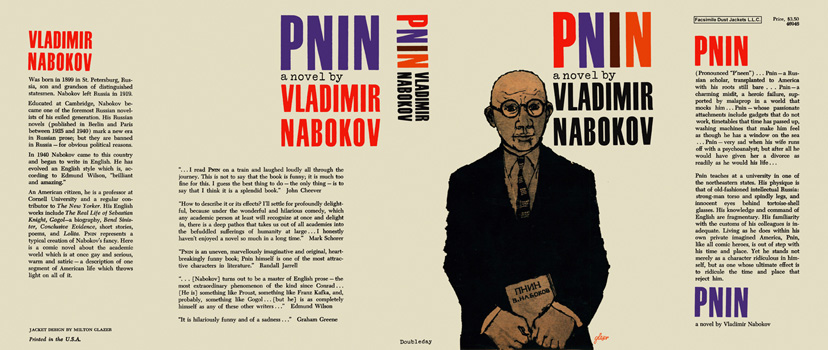
Pnin is a short novel by Vladimir Nabokov originally published in 1957. It was Nabokov’s 13th novel and the 4th one he wrote in English. It tells the story of Timofey Pavlovich Pnin, a fifty-something Russian professor living and teaching in exile in the U.S. Pnin’s life is narrated through the eyes of V. V., another Russian academic.
I found a great deal to admire in Pnin. For one thing, Nabokov’s descriptions and his use of metaphors in the narrative are nothing short of masterful. The ongoing symbolism of the squirrel as the ghost/metaphor for Pnin’s lost love Mira is quite remarkable. Further, this is probably one of the best novels about academia anybody’s ever written. There’s a lot the book can teach writers about how to build tension in scenes where relatively little is physically happening.
But for me it was a slow-going reading experience because I found the narrator so unpleasant. I never found the novel to be light-hearted, as many readers and reviewers apparently have, and I mostly connected with the sadness in it that becomes more prevalent as the book moves on. I disliked the narrator’s contempt towards Pnin, who’s a truly decent character, but I also realize that employing a narratorial voice that treats the protagonist viciously while simultaneously conveying Pnin’s goodness and humanity is something only a writer of tremendous skill can manage.
The scene that interested me the most was the one in which Pnin flashes back to the time when he was sick as a boy and became obsessed with the wallpaper in his room:
He had always been able to see that in the vertical plane a combination made up of three different clusters of purple flowers and seven different oak leaves was repeated a number of times with soothing exactitude; but now he was bothered by the undismissable fact that he could not find what system of inclusion and circumscription governed the horizontal recurrence of the pattern; that such a recurrence existed was proved by his being able to pick out here and there, all along the wall from bed to wardrobe and from stove to door, the reappearance of this or that element of the series, but when he tried traveling right or left from any chosen set of three inflorescences and seven leaves, he forthwith lost himself in a meaningless tangle of rhododendron and oak.
I wondered if Nabokov was deliberately evoking “The Yellow Wallpaper” by Charlotte Perkins Gilman, which was written 65 years before Nabokov’s novel. In Gilman’s story, the protagonist becomes obsessed with the floridly ugly wallpaper in the bedroom of the country manor her husband has rented for the summer. She first tries to make sense of its weird, conflicting, confounding patterns – much as she’s trying to make sense of the complex, illogical rules and double standards of the patriarchal world she’s trapped in. Then she starts to see malign eyes moving inside the pattern. As her madness progresses, she starts to see the image of a lurking woman trapped inside the pattern, and the narrator becomes obsessed with getting her out.
Pnin, on the other hand, doesn’t fall prey to insanity as he tries to make sense of his own wallpaper, although whoever designed the paper is described as “the destroyer of minds, the friend of fever”. But as a metaphor, the wallpaper in Nabokov’s chapter could function in much the same way as Gilman’s: Pnin has become aware that he’s trapped in a world he cannot fully understand or navigate despite his best efforts. Does he escape insanity because he, as an educated man, is not oppressed by society to the same extent that Gilman’s female protagonist is? If Nabokov was deliberately referencing the themes and images of Gilman’s story, that conclusion seems likely.
Leave a Reply
You must be logged in to post a comment.